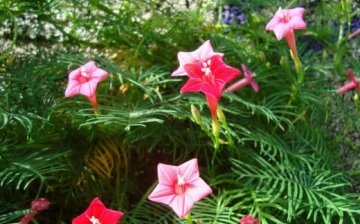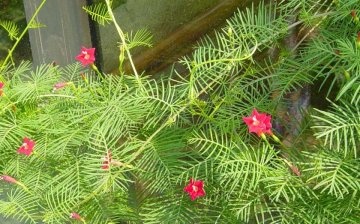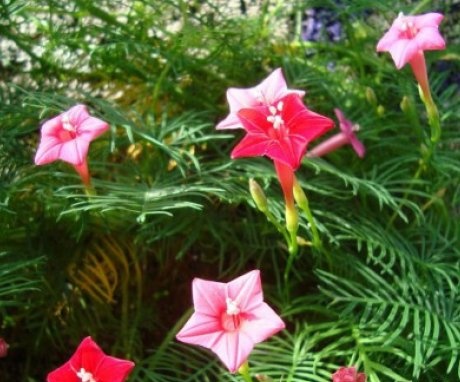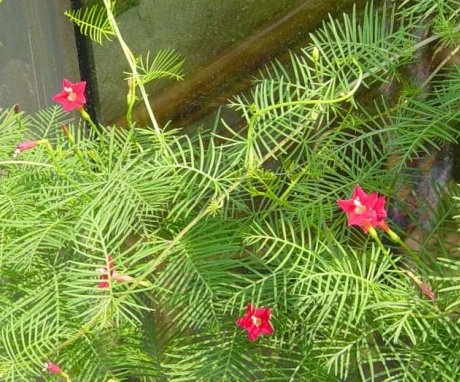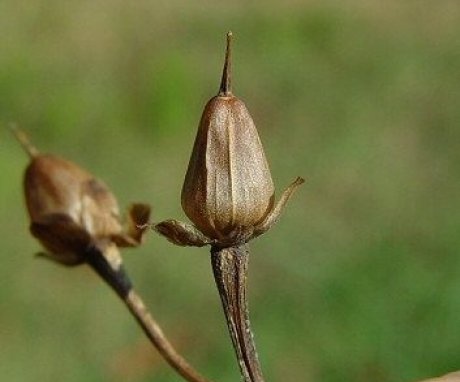Quamoklite pinnate: description of the species, growing conditions and methods of reproduction
Kvamoklit pinnate, or morning glory, or mine is an annual plant that belongs to the bindweed family. It came to us from India and until now it is extremely rare to meet it in natural conditions.
Content:
Description of the plant
The flowering period is July-September. Kvamoklit is a liana, each stem reaches a length of 2 meters if it grows in a garden area and 5 meters if it grows in natural conditions. Shoots are flexible and sinuous, green in color, develop better in partial shade and sunny areas.
If kvamoklite pinnate grows near the support, then the vines will twine around it and grow up.
Characteristic features of the plant:
- The leaves of the liana are densely planted, they are openwork, the color is bright green, finely dissected in shape, some people compare the leaves of kvamoklite with a feather. If the growing conditions are favorable, then the leaf size can reach 10 cm, in unfavorable conditions, less.
- The flowers of kvamoklite are tubular, they are numerous, the plant does not completely cover the plant, and are arranged in groups. The flowers are very bright, immediately striking, the diameter of each is no more than 2 cm, the color can be white, red or pink, the limb is star-shaped.
- The unusual shape of the leaves complements well correct flower shape... A feature of the cirrus quamoclist is the short life cycle of each flower, it lasts only one day. But throughout the entire flowering period, the wilted flower is replaced by a new one, so visually it seems that kvamoklite blooms constantly.
If all the growing conditions are met, then you can independently extract seeds from the kvamoklite flower. In April it will be possible to start sowing and growing them.
There are several types of kvamoklite:
- Pinnate.
- Lobed.
- Fiery red.
- Slaughter.
In order for the plant not only to be conveniently located, but also to decorate the garden, flower growers use a support in the form of a pyramid, its most advantageous position will be opposite an empty lawn. Also quamoklite pinnate is used forpainting balconies, gazebos and walls.
Growing and care
Growing kvamoklit is quite simple, even an amateur gardener can handle it. No special knowledge or unnatural conditions are required. You can grow kvamoklit on the balcony, at home, in the garden for decorating walls, fences, lawns, etc.
Kvamoklit is unpretentious to the soil, it can be grown in sandy-humus soil. It is good if it is not very fertilized, loose, with sand, ash, carefully processed.
When growing in a garden plot, you need:
- Choose a well-lit area.
- The plant can develop on supports, or maybe in pots, hanging over the edges, tying vines, you can adjust the direction of its growth.
- Kvamoklita is provided with moderate watering, every week during the period active growth, top dressing is applied.
Kvamoklit is extremely sensitive to spider mites. It can envelop the whole plant. It is not difficult to deal with it, it will be enough to remove the cobweb and wipe the plant with cold water. You can additionally use special chemicals.
Choose the type of kvamoklite it is necessary depending on the region of cultivation, but the care for all species is provided the same, despite the fact that the flowering periods occur at different times.
Growing secrets:
- It is necessary to transplant kvamoklit carefully. For a plant, this is a great stress, due to which it can get sick and even die. Only one species does not tolerate transplantation at all, it is pinnate quamoklite.
- Therefore, when growing it for seedlings, problems may arise. but sowing seeds directly into the ground can be dangerous in our climatic zone, since frosts are possible in winter.
- As for watering, you can follow this recommendation: pour warm water once every three days. One adult plant has 1 liter of water.
Although plant and exotic, it is easy to care for him. As for the supports, they are built before planting vines, and not after, when the root system and shoots have formed. Shoots develop very actively, if you do not immediately provide them with support, then this will adversely affect the appearance of the vine. Foliage and vines can become entangled with each other.
It is better to use complex mineral fertilizers as top dressing. They begin to make them in May, finish in August.
In order to protect quamoklit from spider mites, prevention is carried out. Once every three days, they spray it with cold water, in such conditions the parasite will not develop.
Since kvamoklite loves sunlight, its vines can be used both to decorate the gazebo and at the same time to shade.
Reproduction of cirrus quamoklite
To propagate quamoklite on your own will require certain knowledge and skills. It has already been mentioned that not all types of kvamoklite tolerate transplanting, and some do not tolerate at all, so planting seeds for seedlings is a risky business.
With regard to seed propagation, then:
- They are planted in open ground only with full confidence that frosts are not expected. If frosty weather is expected, then the seeds are sown in containers in March, and in May the seedlings are transplanted into open ground.
- Due to the transplant, the plant can get seriously ill, so you need to be careful with seedlings. If you sow seeds in open ground in a warm period of time, that is, in May, then kvamoklit will bloom late, which means the seeds will not have time to ripen.
- It is advisable to do the following operation: sow the seeds into the ground, make a mini-greenhouse on top of the plot so that frosts do not damage the seeds. At this stage, the plant is watered moderately and frequently.
- All seeds show good germination, the plant develops rapidly, actively gaining deciduous mass. All species, except for pinnate, can be transplanted, so it is not necessary to wait for the frost to end, but you can plant seeds in boxes at home.
- If the seeds are sown immediately to a permanent place of growth, then this should be a place where there is a lot of sunlight and sandy-humus loose soil.
- If the spring has dragged on, and the planting of pinnate quamoklite was planned this season, then the seeds are sown in boxes, like any other plant varieties.
For growing seedlings, a universal land mixture is suitable. Seedlings can be planted as soon as the threat of frost passes.
The best time for planting kvamoklite seedlings is May.
It is not recommended to deeply deepen the seedling. When growing on a site, the distance between the vines should be more than 30 cm.To avoid unpleasant consequences, you need to immediately build a support along which the quamoklite will be understood upward.
Experienced gardeners advise building a support no later than a week after the seedlings have been planted, and no later than a month after the seeds have been sown.
For the construction of the support, wires, wooden boards, ropes, etc. are used, they determine the direction of growth of vines. To keep the plant healthy, the seeds are soaked in warm water for a day in advance. They land in the depths about 1 cm, the soil is immediately watered. Seedlings will appear in 2 weeks, maybe even earlier. The ambient temperature should be maintained at about 20 degrees.
There are no difficulties in growing and reproducing kvamoklite. The main thing is to know the features of each species and correlate them with the conditions of the growing region.
More information about kvamoklite can be found in the video.




